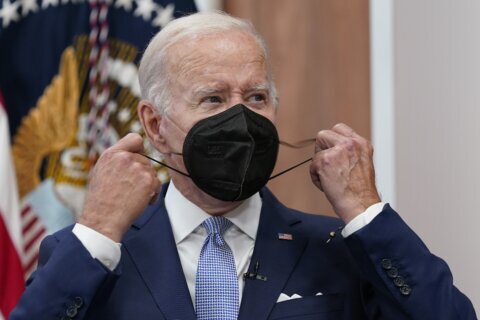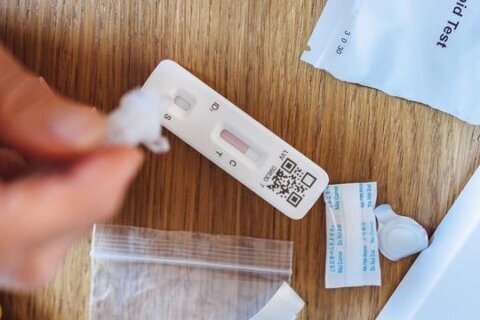This article was republished with permission from WTOP’s news partners at Maryland Matters. Sign up for Maryland Matters’ free email subscription today.
This content was republished with permission from WTOP’s news partners at Maryland Matters. Sign up for Maryland Matters’ free email subscription today.
As pharmaceutical companies race to get a COVID-19 vaccine on the market, Maryland lawmakers and policy experts have found themselves rushing to find ways to motivate the public to go out and get it.
”The challenges are great,” Dr. David Marcozzi, COVID-19 Incident Commander for the University of Maryland Medical System, warned the Joint COVID-19 Legislative Response Workgroup Wednesday.
According to a recent Goucher College poll, 49% of surveyed Marylanders would refuse to be inoculated if an FDA-approved COVID-19 vaccine were made available today.
“Right now, Marylanders are not confident about the COVID-19 vaccine,” Marcozzi told lawmakers. “Since it has not been approved, we do have time [to change people’s minds] — but not much.”
While general confidence surrounding the safety and efficacy of the rushed COVID-19 vaccine has been low, that mood is multiplied in communities of color across the state who have been disproportionately affected by the virus.
Dr. Letitia Dzirasa, commissioner of the Baltimore City Health Department, urged the workgroup to emphasize partnerships with trusted community leaders as a way of reaching skeptical minority populations.
“We know that there is medical mistrust and concerns about the efficacy and safety of this vaccine,” said Dzirasa, “so we really need to work very closely with our fellow qualified health centers, as well as trusted minority leaders in the community to make sure that the messaging on the importance of this vaccine is heard.”
Promoting a vaccine that pharmaceutical companies are working at break-neck speed to deploy to traditionally hesitant groups is no easy feat — especially when those who are more trusting of the medical community are uncomfortable, too.
‘Accelerating through’
Dr. Wilbur H. Chen, an infectious disease expert and professor at the University of Maryland School of Medicine, said that fully developing a vaccine typically takes a decade.
“We are accelerating through this,” he said. “And we are right now only 10 months into this pandemic, and we’re already talking about phase three studies and we’re already talking about trying to think about delivery so that we can make an impact.”
Phyllis Arthur, vice president of infectious disease and diagnostic policy at Biotechnology Innovation Organization, said that manufacturers are able to speed through development because of the kind of vaccines that are being developed: instead of using the actual virus in their formulas, several companies are using its genetic sequencing data.
“Where we are continuing to spend the same time is on the kinds of trials that are being done,” she said.
Chen told lawmakers that, in order for vaccines to hit the market, manufacturers have to go through a number of developmental steps, including the preclinical phase, which is typically when vaccines are tested on lab animals, and three phases of human clinical trials:
- Phase one seeks to evaluate the safety of the vaccine in about 100 human test subjects;
- Phase two looks at immune responses in hundreds to thousands of participants;
- And phase three looks at the vaccine’s safety, common adverse effects and efficacy in tens of thousands of people.
After clinical trials, manufacturers seek regulatory approval, or licensure, from the government, work on policy and financing and then deliver the vaccine and monitor its effects.
According to the Food and Drug Administration, before a vaccine can be licensed, manufacturers need to prove its safety, immune response and efficacy against symptomatic, lab-confirmed infection across populations, including in high-risk individuals and communities of color.
The FDA says vaccines must have a minimum 50% efficacy rate to be licensed.
“Now you might say, ‘50%, that’s not good enough,’ but a 50% efficacy against preventing symptomatic infection is what we’re looking at,” Chen explained, “but also [if] it prevents 90% [of] hospitalizations, that’s a very valuable vaccine.”
At the forefront of the race for a U.S.-produced COVID-19 vaccine are five companies: Pfizer, Moderna, AstraZeneca/Oxford, Johnson&Johnson and Novavax. All of these companies have moved into the third phase of their clinical trials, but it’s unclear which will cross the finish line.
“Globally, worldwide there are 180 different vaccines in development,” Chen said. “But these are the leading candidates here.”
Chen, who sits on the U.S. Centers for Disease Control and Prevention’s Advisory Committee on Immunization Practices, said that the body is beginning to prepare what the deployment policy for any licensed COVID-19 vaccines will be.
Under the assumption that there may be a supply shortage, the advisory committee is developing a tiered system to determine who will be the first recipients, with the first priority falling to populations at the highest risk of infection.
‘All subject to change’
The Maryland Department of Health submitted its vaccine distribution plan to the federal government on Oct. 16.
Health Secretary Robert R. Neall called the plan a “draft” that he expects will evolve over time.
At this point, the Maryland Department of Health plans to dole out vaccinations in two phases, starting first with those at greatest risk of contracting COVID-19, including:
- Maryland’s 322,280 health care workers;
- 41,260 first responders;
- 43,160 older adults in congregate living facilities;
- 54,460 inmates and staff in state and local detention centers;
- And 390,000 people with comorbidities and underlying conditions.
Dr. Jinlene Chan, deputy secretary of public heath services for the Department of Health, said that this is “all subject to change” based on guidance from the Advisory Committee on Immunization Practices and the vaccine’s efficacy for different populations.
Chan said that the state will move into phase two when a significant portion of this higher-risk population is inoculated. At that point, the general public will be able to get vaccinated at their doctor’s office or pharmacy, “similar to how they would receive a flu shot now,” Chan explained.
“Ultimately, our goal is that any Marylander who wants to be vaccinated will be able to receive a vaccine,” she said.
Like Dzirasa, Chan emphasized the need to reach minority communities in “culturally competent” ways to ensure that they know how important this vaccine is.
“This is going to be the most critical work that we are doing in weeks and months ahead,” Chan said.
As the state begins to prepare for any incoming vaccines, lawmakers question who is ultimately responsible for their distribution.
“Is it local distribution? Is it the partners? Is it the State Department of Health? The state-level? Is at the federal government?” asked Senate President Bill Ferguson (D-Baltimore City). “As you look forward, where does the buck stop for Maryland’s vaccine distribution plan?”
“I think the buck stops with the Maryland Department of Health,” said Neall. “We’ll have partners and we’ll have people who work with us, but if you’re looking for a one-stop-shop, I think it’s the Maryland Department of Health.”







